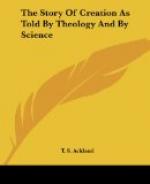The nebular theory.
We come now to the consideration of the Nebular Theory of Laplace, in so far as it is opposed to the Mosaic account. It must be remembered that, after all, this is only a theory. Even if it could be satisfactorily established, it would only point out a way in which this world might have been formed. That it could not have been formed in any other way is an independent proposition, in support of which no single argument has ever yet been brought forward. There may be a greater or less probability that the earth was formed in this particular way, that probability depending on the extent to which the theory accounts for observed facts. This it does in many cases, and it has in consequence been accepted as A whole by many scientific men, as a substitute for the Scriptural account. As will be seen hereafter, there are strong reasons for admitting it as a supplement to the brief account given by Moses; but our business now is to ascertain, whether it has any just claim to be received instead of that account.
The theory seems to have been suggested by certain speculations of Sir W. Herschel. In his telescopic examination of the Nebulae and star clusters, he found that in a great number of cases, when a nebula was rendered visible by a certain amount of telescopic power, it would be resolved into separate stars by a telescope of a little higher power. But there were some nebulae, visible in very small telescopes, or even discernible with the naked eye, such as those in Orion and Andromeda, which could not be resolved even by his great four-foot reflector, the largest telescope that had then been constructed. And these nebulae exhibited a great variety of forms. Some of them were vast shapeless masses of faint light; others, which he designated “planetary” nebulae, exhibited a regular form—a circular disc more or less clearly defined, often brightest in the centre. Others seemed to be intermediate between these two classes. Hence he was led to the idea that these were worlds in the process of formation, and that their varying forms indicated varying stages of that process.




